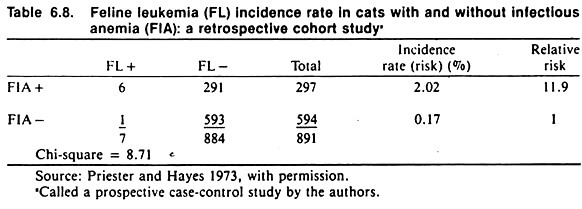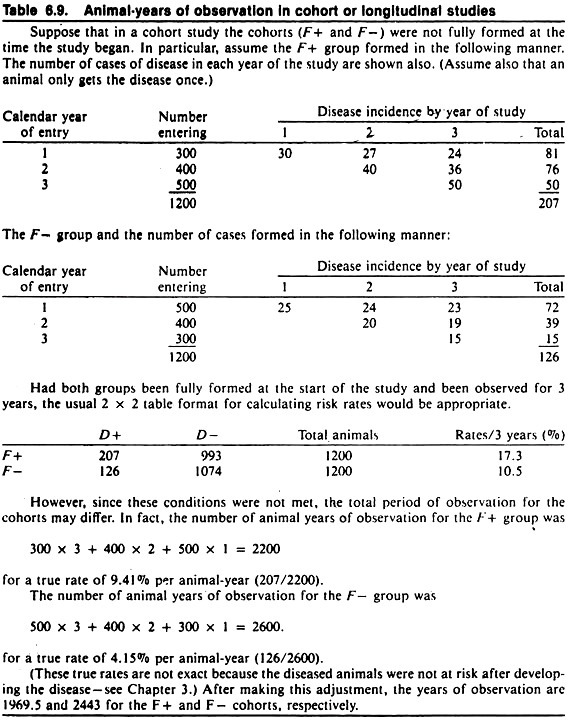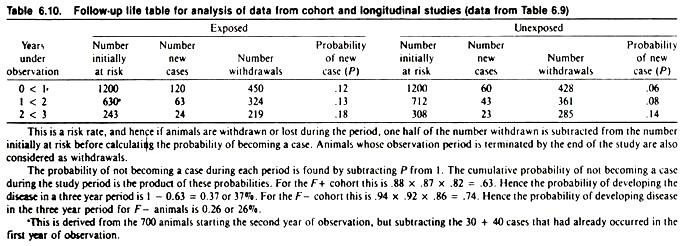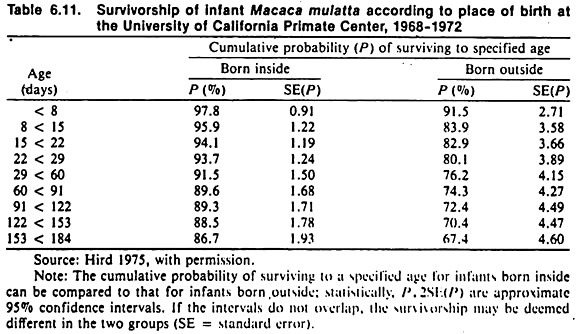In this article we will discuss about:- 1. Selection of Exposed and Unexposed Groups 2. Follow-Up Period in Cohort Disease 3. Determining Occurrence of Disease 4. Analysis.
1. Selection of Exposed and Unexposed Groups:
In most cohort studies, special exposure groups are purposively selected for comparison. This could include comparing rates of disease(s) in different breeds; comparing rates of pneumonia in animals on different rations; comparing rates of disease in animals with and without serum antibodies to selected antigens; or comparing disease rates and production levels in herds on preventive medicine programs to similar herds not on these programs.
The sampling units are frequently obtained through purposive sampling, not probability samples from a defined sampling frame. Because of this and in order to extrapolate results beyond the study groups, some indication of how representative the study groups are of exposed and unexposed segments of the population should be obtained.
A further concern in selecting the cohorts is that they should be comparable (i.e., not differ in ways other than the exposure). This may require the measurement of ancillary variables so that analytic control can be used to adjust for known differences between the groups, although matching may be used to increase the similarity of the groups as it was in case-control studies. More than one unexposed group may be selected as the referent if the information provided will be useful.
ADVERTISEMENTS:
For example, in a study of the effects (benefits) of preventive medicine programs, the comparison group might include two groups – the first composed of herds using veterinary service regularly, but not a formal prophylactic program; and the second composed of herds using veterinary service only irregularly. Obviously, a clear and practical set of definitions of the different types of veterinary service would be required.
Although the exposure status of selected units may seem obvious, the probability of misclassification of exposure status can be reduced by clear, concise descriptions of what constitutes exposure (possession of the factor).
Specific tests may be used to help assess exposure status in a manner similar to their usage as diagnostic aids. When feasible it is useful to classify the cohorts according to a gradient of exposure, allowing investigation of a potential dose-response relationship.
If pre-recorded data on exposure history are used to define the cohorts, investigations into the meaning, validity, and completeness of the data should be performed. Certainly one should not interpret “no recorded history” of exposure as meaning no exposure, unless the records are known to be complete.
ADVERTISEMENTS:
In prospective studies, the collaboration of a number of people will be required. Hence, it is important that a high percentage of selected individuals cooperate in the study, and failing this, the study design should increase the likelihood of equal cooperation rates in the exposed and non-exposed groups.
If these rates are very different, lack of cooperation can distort the results of the study in the same manner as differential admission rates in case-control studies. In general, it is informative to elucidate reasons for lack of cooperation.
Whenever possible, all the sampling units entering the study should be examined for the presence of the disease(s) of interest at the start of the study. By starting the study with disease-free units, the investigator can determine incidence rates, and this also establishes a clear temporal relationship between the factor and disease.
Sometimes such an examination is very difficult; thus the sampling units are assumed to be disease-free at the start of the study. This is frequently true in retrospective cohort studies.
2. Follow-Up Period in Cohort Study:
ADVERTISEMENTS:
The cohorts should be observed for the occurrence of disease(s) at regular periods throughout the study; both groups should be followed with equal rigor; and the withdrawal of sampling units from the study should be minimized. Withdrawals can bias the results if the losses are related to both exposure and disease status. Obviously, this problem is more severe in studies spanning many years.
If a high percentage (e.g., 95%) complete the study, potential biases from withdrawal will be minimized. Care is also required when cohorts are defined retrospectively, because many withdrawals (due to culling, sale, or death) will have occurred before the study begins.
For example, if the weight gain and feed efficiency of a group of swine that received antimicrobial therapy were compared to that of an untreated group, one would have to note and adjust for death losses prior to slaughter. Such losses might not negate the results, but their potential significance should be borne in mind. Whenever possible, the reason(s) for withdrawal from a prospective cohort study should be recorded.
3. Determining Occurrence of Disease:
The diagnostic criteria for the disease of interest must be clearly defined, and whenever possible those, making the diagnosis should be unaware of exposure status of the units being examined. Since more than one disease may be of interest, the criteria for diagnosing a few important diseases should be specified in detail, with other diseases being diagnosed and recorded in a rigorous but ad hoc manner.
4. Analysis of Cohort Study:
If the duration of the study is relatively short, the average period of risk is equivalent in both cohorts, and the losses to follow up are minimal, the usual 2×2 table format may be used to display and analyze the data (see Table 6.8). The rates of disease in each cohort are calculated and compared directly, or the Mantel-Haenszel technique, or standardization of rates may be used to control the effects of extraneous qualitative variables.
Often the duration of the period at risk may differ greatly between cohorts. This is particularly likely when the cohorts are not completely formed at the start of the study. If the study is designed to last 3 years, the cohorts may be formed over this period as appropriate exposed and unexposed individuals are identified and placed under observation. A hypothetical example of this situation and the problems it creates is provided in Table 6.9.
Two analytic approaches are used to adjust for the differing periods of observation. The first method is based on the calculation of true rates and the concepts of unit-time (for example animal-years) of risk. Each animal or sampling unit contributes 1 year each full year it is under observation (e.g., 1 unit observed for 3 years contributes 3 unit years of observation, and 3 units observed for one year also contribute 3 unit-years).
ADVERTISEMENTS:
The total unit-time of risk in each group is used as the denominator for calculating true rates in the usual manner. Although these data may be summarized in a 2 x 2 table, the regular chi-square test should not be applied to these data.
Thus, using true rates is useful for removing biases from differences in period of risk, but does not allow the evaluation of the role of chance by standard statistical methods. If the groups are very large, sampling variation is not of great importance and may be ignored.
The second analytic approach is the follow-up life table method that allows the investigator to calculate risk rates. This is accomplished by taking into account the different periods of risk, and the technique also allows formal statistical evaluation of observed differences. This method is introduced in Table 6.10 as an extension of the problem presented in Table 6.9. An example of the application of follow-up life tables is shown in Table 6.11.



